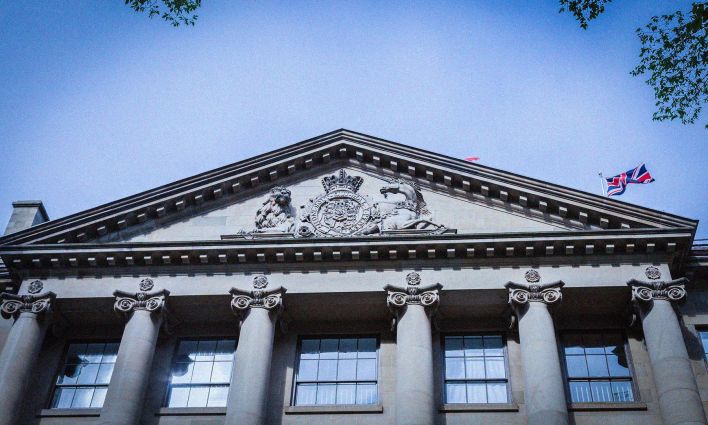The performance of the Nova Scotia economy is a mixed bag. After years of little or no employment growth, the labour market improved marginally in 2018. Overall employment increased by 2.1%, and the unemployment rate decreased from 8.2% to 6.9%, still significantly higher than the national rate of 5.8%. These aggregate figures, however, obscure regional and demographic differences. Employment continues to decline in regions such as the North Shore, the Annapolis Valley, and especially Cape Breton, where the unemployment rate increased to 16.7%. Province-wide, the youth unemployment rate remains high at 13.4%.
Despite the incremental improvement in Nova Scotia’s aggregate employment statistics, real wage growth is non-existent. In 2018, average weekly earnings increased by only 1.2%, barely keeping pace with inflation and less than half the national growth rate of 2.6%. Earnings growth is on a downward trajectory, falling in each of the past four years. The province’s anemic earnings growth is only worsened by provincial government policies, such as maintaining the lowest minimum wage in the country and labour contracts forcing real wage cuts on teachers, nurses, and other public servants.
Economic growth remains sluggish. The Finance Department’s December Forecast Update projects real GDP growth of only 1% in 2018 and 0.6% for 2019. Since the current government came to power, real economic growth averaged a paltry 1% compared to 1.9% for the national economy. With provincial government spending making up roughly a quarter of its economy, Nova Scotia’s performance has not been helped by its government’s spending restraint to generate surpluses and achieve arbitrary budgetary goals.
The small gains in the Nova Scotian economy are not trickling down to our most disadvantaged citizens. To paraphrase former US President Harry Truman, the measure of any society (and, by extension, its economy and government) is how it treats its most vulnerable members. By this measure, the Nova Scotia economy and government fail miserably.
High Poverty Rates
Nova Scotia has the highest poverty rate in Canada, at 12.8%. The poverty rate for couple-led families with children increased between 2016 and 2017 to 12.3%, the highest in Canada. Along with the persistently high level of poverty for lone parent families (26.4%), these high poverty rates affect Nova Scotia’s children where the poverty rate of 17.1% is by far the highest of any Canadian province and almost twice the national rate of 9.0%. Those who rely on social assistance do not receive enough support to cover their needs; for example, single people receive 38% of the income needed to buy a basic basket of goods. The 2-5% increase promised by the current government, is insufficient and indeed shameful given that the lowest poverty gap for a family with two children would require an increase of 29% to meet their basic needs for food, shelter, clothing.
What about our fiscal health? The budget is balanced, and in 2016-17 and 2017-18 the provincial government generated surpluses of $151 million and $230 million respectively. The debt-to-GDP ratio has fallen to 34.6% and is projected to fall further. Our debt-GDP ratio is much lower than Ontario’s or Quebec’s which have projected ratios of around 40%. With continuing low interest rates, the government is trading in high cost for low cost debt. Consequently, the interest on its debt is in decline, and the ratio of debt servicing costs to revenue has fallen considerably over the past five years, from 8.8% to 7.0%.
The government’s primary focus on fiscal health means that it largely neglects the health and wellbeing of Nova Scotians. Our government has missed opportunities over the last 6 years to make critical public investments that would see our province shift to a bottom-up inclusive green growth strategy, from one centred on failed payroll rebates to profitable companies while denying that our planet’s very existence is in peril.
Address the climate crisis
The government must use this opportunity to be bold, to address the climate crisis and make a significant investment in a just transition to renewable energy and a green economy. A Green New Deal is being proposed in the United States and is now being discussed in Canada, with many aspects echoing the visions of the Leap Manifesto and the 2030 Declaration. These blueprints for change have indeed been the backbone to alternative budgets in Nova Scotia, and federally. The Canadian Centre for Policy Alternatives’ lens for creating the alternative federal budget and the Nova Scotia alternative budget combine social, economic and environmental justice.
Nova Scotia needs to set targets in line with the Paris Agreement’s goal of keeping warming below 1.5C, by setting a target of at least 50% below 1990 levels by 2030. By achieving this goal, and making investments in the just transition to a green economy, Nova Scotia can create more than 30,700 jobs, according to the Green Economy Network. The development of a green jobs plan could be a starting place.
Our analysis shows what governments could and must do to begin to invest in the tenets of a green new deal for Nova Scotia - within a framework that is fiscally sustainable. Table 1 compares the fiscal baseline projected by the Nova Scotia government to our fiscal situation should we invest an additional billion dollars. Our projections also include a cost of living increase in current expenditures, reallocate some revenue, raise additional revenue by improving the progressivity of the tax system and generating revenue from a strengthened carbon pricing initiative. The result is the debt to GDP ratio increases only slightly, remains fairly stable and in 2022 starts to decline. Concern about overburdening the next generation with debt payments is misplaced; Debt is deferred taxation that is spread out over a lifetime. There are not many opportunities left before we ‘burden’ the next generation with a dead planet.
TABLE 1
| (Thousands $) | Fiscal Baseline
2018-19 |
Alternative Budget 2019-20 | Alternative Budget 2020-21 | Alternative Budget 2021-22 |
| Revenue | $10,525,400 | $11,764,152 | $12,232,287 | $12,947,398 |
| Programme Spending | $9,667,900 | $12,112,704 | $12,537,469 | $13,189,940 |
| Budget Balance | $28,100 | -$348,552.00 | -$305,182 | -$242,542 |
| Debt to GDP | 35% | 35.78% | 35.98% | 35.80% |
What do we propose to do with this new billion-dollar investment and what impact could it have?
Green New Deal
The green new deal we propose builds on the successes of the original new deal President Roosevelt instituted to address the first great depression in the United States. We need to see similar urgency and level of investment to stimulate the economy, to share the prosperity that exists, to address income inequality, injustice, and the climate crisis.
Our alternative budgets have proposed investments to reduce GHG emissions while ensuring energy is accessible to all Nova Scotians, regardless of income, through fair and progressive taxation and smart investment decisions. (See our spreadsheet for a detailed breakdown of spending and revenue reallocation and generation.) Our proposed investments in climate change mitigation result in lower energy costs and reduced debt by improving energy efficiency, will make our homes more comfortable, and will make it easier to use public transportation. These investments, including in reskilling and training, will support the increased growth of green-sector jobs to support a low-carbon transition.
Our alternative budget backgrounder lays out in detail how the government could enact this plan. These investments will also reduce illness and healthcare costs as pollutants related to fossil fuel combustion decrease. By phasing out coal-fired electricity by 2030, Nova Scotia can avoid 11 premature deaths, 1,200 asthma episode, 19,000 days of breathing difficulty and more than $54 million in healthcare costs. In short, this plan must ensure that those who have been burdened disproportionately by the climate crisis, and who are largely not to blame, do not now bear the costs, including our youth, workers in the non-renewable energy sector, those living in low income, people of colour, and Indigenous Peoples. We must commit to building a just, green economy and society now.
Our alternative budgets prioritize investment to create jobs in the parts of our economy that are already green –those parts focused on caring, sharing, educating our people, building community, and on supporting everyone’s health and wellbeing. Investment to improve access to primary health care, while working to prevent problems from arising in the first place because of poverty conditions, is investing in good jobs that serve the needs in our community. For example, we invest to significantly reduce poverty by investing in the poverty reduction credit (an increase of $2000 per adult), increase the affordable living tax credit ($450 per adult and $120 per child) and double the Nova Scotia Child Benefit, plus providing an increase to social assistance rates themselves and instituting a carbon benefit to offset carbon price increases for people living on low incomes. Investments in real affordable and supportive housing options across our province are critical.
The biggest bang for our investment dollar is undoubtedly in our children and thus investments in early learning and child care and our primary to 12 education system, must be prioritized. Our youth should not have to incur such huge debt loads for post-secondary education. We can reallocate resources and invest to reduce and eliminate tuition fees and to forgive student loans. Our arts and cultural sector, our libraries, our museums, are undervalued critical community infrastructure. Investments in this sector are not only reasons people come to visit, social and cultural infrastructure along with quality public services, and decent jobs, are why they choose to stay.
Nova Scotians need to raise their expectations for what our government can achieve, and what we can achieve collectively. We can build a greener, healthier and just province. This is the lens through which the government’s 2019-20 budget should be judged.
Christine Saulnier, Nova Scotia Director, CCPA, and James Sawler, Associate Professor, Economics, Mount Saint Vincent University







